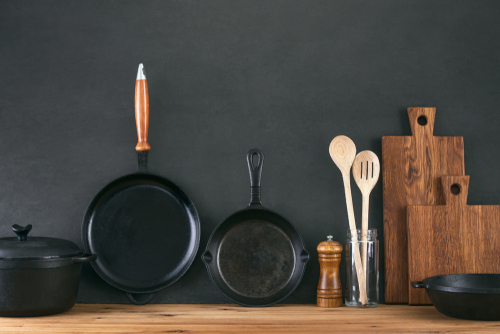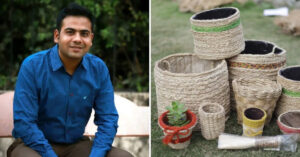How to Care For Your Traditional, Sustainable Cookware So it Lasts Longer
Whether it is cast iron or brass, sustainable cookware needs to be properly cleaned and maintained so that it can withstand damage and remain durable for a long time.

One of the best things you can do for your health is to switch to good quality cookware. Pots and pans made of materials such as cast iron, soapstone, clay, copper and brass have been used in traditional Indian kitchens and are known to be healthy and green options because they do not leach toxic chemicals into food and, consequently, into our bodies and the environment. But, as important as investing in sustainable cookware is its maintenance. These dishes are durable, and, if well-cared for, can last you several years.
Here are a few tips on how to keep your pots and pans sparkling clean and in top condition—without using harsh chemicals.
Cast iron
It is possible to buy a pre-seasoned pan and save yourself the toil of seasoning your cast iron pan. However, if you do choose to buy an unseasoned one, season it before using by applying a thin layer of cooking oil to your pan and placing it on the stove to heat. Repeat this process a few times until multiple layers of oil are baked into the pan. This is what creates a non-stick, rust-resistant layer on the pan.
The first and most important tip in caring for cast iron dishes is to always keep them as dry as possible. Moisture is the enemy of cast iron and rusting begins almost immediately. As soon as you are done cooking in your pan, allow it to cool down to room temperature. Next, fill it with water and place it on the flame, allowing the water to boil. Using a stainless steel spatula, scrape off the grease and stuck-on food particles as the water boils. Next, rinse the vessel with water using mild dish soap and a sponge. Remember to be gentle while scrubbing. Never keep cast iron utensils soaking in water or use harsh, rough scrubbers made of steel wool.
For heavily stuck-on food particles, sprinkle 1-2 tablespoons of salt into the pan along with a few tablespoons of cooking oil. Scrub the mixture with a sponge until the particles are dislodged. Then rinse with water to remove the residue.
After washing, it is important to completely dry the cast iron pan and re-oil it. Wipe it dry with a towel then place the pan on a low flame. Pour a tablespoon of cooking oil into it and, using a tissue, brush the oil to coat the entire surface, including the bottom of the pan until a thin layer of oil is present all over.
Store it in a cool, dry place. You can place a single sheet of tissue to absorb any moisture from the pan.
Stainless steel
Stainless steel dishes are among the easiest to clean. All you need is a sponge or scrubber and a chemical-free cleaner such as The Better Home dishwashing liquid which gets rid of the toughest grease and stains. Unlike regular dish soap, it does not leave behind any residue on the dishes nor does it leave the skin feeling dry and rough.
First, remove any stubborn food particles by applying a paste of baking soda and vinegar. Let the dish sit for a few minutes before scrubbing. Now, apply The Better Home dishwashing liquid and rinse under running water. To battle heavily burnt-on food, soak the dish in a mixture of lime juice and salt for up to 30 minutes. Scour off the residue with more salt. Finally, wash the dish with The Better Home dishwashing liquid.
Earthen or mud pots
Clay pots are a popular choice for making tamarind-based curries, cooking fish and making curd. Mud pots are naturally non-stick so sticking of food is greatly reduced. After cooking, rinse the pot first with plain water and use a scrubber to remove any remaining oil and food particles. Never use dish soap on clay dishes. Due to their porous nature, clay vessels absorb the soap which enters the pores and leaves them smelling of soap. Fill the pot with water and bring it to a boil along with a teaspoon of baking soda and a slice of lemon. The baking soda removes any food and grease stuck in the pores of the dish while the lemon gets rid of any strong odours and flavours. Once the water boils for a minute or two, drain it out and, once again, rinse the pan with plain water. Wipe dry and place the pot on a low flame to remove all the moisture and prevent fungus formation during storage.
Soapstone
After cooking in a soapstone utensil, allow the dish to cool down to room temperature. Placing a hot soapstone dish in contact with cold water can cause the dish to crack. Rinse the cooled dish under running water and remove any stuck-on food particles. Then, fill the dish with water and bring to a boil. You will observe the food particles floating on the surface. Allow the water to cool down before emptying the pot and rinsing it under plain water, scrubbing off any remaining grease and oil with a sponge. Like mud, soapstone is a porous material which will absorb any soap. It is, thus, best to avoid dish soap while cleaning soapstone. Wipe the washed pot clean and sun dry to get rid of any leftover moisture.
Copper and brass utensils
There are several ways to clean copper and brass utensils and restore their shine using easily available kitchen ingredients. One time-tested method of cleaning brass and copper is with a mixture of table salt and tamarind. Sprinkle some salt on the pot and scrub the inside and outside surfaces using a coin-sized ball of soaked tamarind. Once clean, rinse off the residue with plain water and dry with a clean towel. Tamarind can be substituted with other souring agents such as lime juice or vinegar, and the dish can be scrubbed with a regular sponge or scrubber.
Wooden and bamboo spoons
The key to caring for wooden spoons is to minimise their exposure to moisture and heat. After use, allow the spoon to cool down to room temperature before washing with cool water. Do not let wooden spoons sit in water for long periods of time as they may absorb the water and expand. Scrub the spoon with dish soap and sponge to get rid of food particles and oil. Applying a slice of lemon is helpful to remove any strong food odours and flavours that have seeped into the wood. Wipe the spoon dry and let it air dry completely before storing, to prevent fungus from taking root. To keep your wooden spoons, ladles and chopping boards looking as good as new, and lasting longer, give them a coating of coconut oil or olive oil every few months.
This story made me
- 97
- 121
- 89
- 167
Tell Us More
We bring stories straight from the heart of India, to inspire millions and create a wave of impact. Our positive movement is growing bigger everyday, and we would love for you to join it.
Please contribute whatever you can, every little penny helps our team in bringing you more stories that support dreams and spread hope.




















